Bhushan B. Nanotribology and Nanomechanics: An Introduction
Подождите немного. Документ загружается.


364 Bharat Bhushan
The interacting force between the tip and sample in dry conditions is the
Lennard–Jonesforcederivedfrom Lennard–Jonespotential.The Lennard–Jonespo-
tential is composed of two interactions – the van der Waals attraction and the Pauli
repulsion. Van der Waals forces are significant because they are always present.
For a parabolic tip above a half plane with a distance D between the tip and plane,
the Lennard–Jones potential is obtained by integrating the atomic potential over the
volume of the tip and sample. It is given as [99]
V
(
D
)
=
c
12
−
A
D
+
B
210D
7
, (8.15)
where c is the width of the parabolic tip (the diameter in the case of a spherical
tip), A and B are two potential parameters where A is Hamakar constant. This equa-
tion provides expressions for attractive and repulsive parts. The calculations were
made for Lennard–Jones force (total) and van der Waals force (attractive part) for
two Hamaker constants0.04×10
−19
J (representativeof polymers)and 3.0×10
−19
J
(representativeof ceramics)and the meniscusforce for awater film (γ
= 72.5N/m).
Figure 8.37 shows various forces as a function of separation distance. The effect
of two relative humidities and three tip radii was also studied which affect menis-
cus forces. The two dashed curves indicate the spread of possible van der Waals
forces for two Hamaker constants. The figure shows that meniscus forces exhibit
weaker distance dependence. The meniscus forces can be stronger or weaker than
van der Waals forces for distances smaller than about 0.5 nm. For longer distances,
the meniscus forces are stronger than the van der Waals forces. van der Waals forces
must be consideredfor a tip–sampledistance upto a fewnm (D < 5 nm).The menis-
cus forces operate until the meniscus breaks, in the range 5–20nm [99].
8.3.9 Scale Dependence in Friction
Table 8.3 presents adhesive force and coefficient of friction data obtained on the
nanoscale and microscale [24,106,107]. Adhesive force and coefficient of friction
values on the nanoscale are about half to one order of magnitude lower than that
Table 8.3. Micro- and nanoscale values of adhesive force and coefficient of friction in micro-
and nanoscale measurements [106]
Adhesive force Coefficient of friction
Sample Microscale
a
Nanoscale
b
Microscale
a
Nanoscale
b
(µN) (nN)
Si(100) 685 52 0.47 0.06
DLC 325 44 0.19 0.03
Z-DOL 315 35 0.23 0.04
HDT 180 14 0.15 0.006
a
Versus 500-µm-radius Si(100) ball,
b
versus 50-nm-radius Si
3
N
4
tip
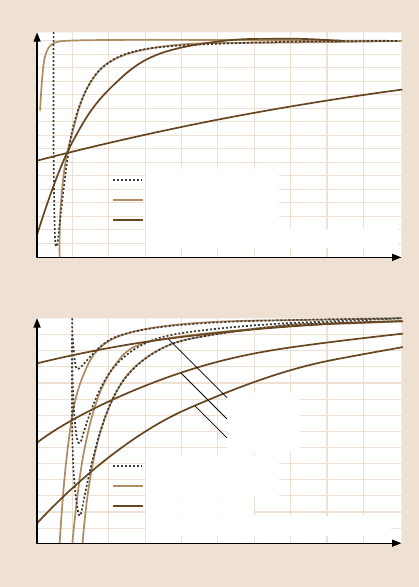
8 Nanotribology, Nanomechanics and Materials Characterization 365
F (nN)
D (nm)
05
0
–2
–4
–6
–8
–10
–12
–14
–16
1234
F (nN)
D (nm)
0 2.5
0
–10
–20
–30
–40
–50
–60
–70
0.5 1 1.5 2
p/p
0
= 0.9
p/p
0
= 0.1
Lennard-Jones force
van der Waals force
meniscus force
γ
l
= 72.5 N/m, θ
1
= θ
2
= 0°, R = 20 nm
Lennard-Jones force
van der Waals force
meniscus force
γ
l
= 72.5 N/m, p/p
0
= 0.1, θ
1
= θ
2
= 0°
R = 20 nm
R = 50 nm
R = 80 nm
a)
b)
Fig. 8.37. Relative contri-
bution of meniscus, van der
Waals and Lennard–Jones
forces (F) as a function of
separation distance (D)and
at (a) two values of relative
humidity (p/p
0
) for tip radius
of 20 nm and Hamakar con-
stants of 0.04×10
−19
Jand
3.0×10
−19
J, and (b)three
tip radii (R) and Hamakar
constant of 3.0×10
−19
J [99]
on the microscale. Scale dependence is clearly observed in this data. As a further
evidence of scale dependence, Table 8.4 shows the coefficient of friction measured
for Si(100), HOPG, natural diamond,and DLC on the nanoscale and microscales. It
is clearly observed that friction values are scale dependent.
To estimate the scale length, apparent contact radius at test loads are calculated
and presented in the table. Mean apparent pressures are also calculated and pre-
sented. For nanoscale AFM experiments, it is assumed that an AFM tip coming into
contact with a flat surface represents a single asperity and elastic contact, and Hertz
analysis was used for the calculations. In the microscale experiments, a ball com-
ing into contact with a flat surface represents multiple-asperity contacts due to the
roughness, and the contact pressure of the asperity contacts is higher than the ap-
parent pressure. For calculation of a characteristic scale length for multiple-asperity
contacts, which is equal to the apparent length of contact, Hertz analysis was also
used. This analysis provide an upper limit on the apparent radius and a lower limit
on the mean contact pressure.
There are several factors responsible for the differences in the coefficients of
friction at the micro- and nanoscale. Among them are the contributions from wear
and contaminant particles, transition from elasticity to plasticity, and meniscus ef-

366 Bharat Bhushan
Table 8.4. Micro- and nanoscale values of the coefficient of friction, typical physical properties of specimen, and calculated apparent contact radii and
apparent contact pressures at loads used in micro- and nanoscale measurements. For calculation purposes it is assumed that contacts on micro- and
nanoscale are single-asperity elastic contacts [114]
Coefficient of friction Apparent contact radius Mean apparent pressure
at test load for at test load for
Sample Micro- Nano- Elastic Poisson’s Hardness Microscale Nano- Microscale Nanoscale
scale scale modulus ratio (GPa) (µm) scale (GPa) (GPa)
(GPa) (upper
limit)
(nm) (lower limit)
Si(100) wafer 0.47
a
0.06
c
130
e,f
0.28
f
9–10
e,f
0.8–2.2
a
1.6–3.4
c
0.05–0.13
a
1.3–2.8
c
Graphite (HOPG) 0.1
b
0.006
c
9–15
g
(9) − (0.25) 0.01
j
62
b
3.4–7.4
c
0.082
b
0.27–0.58
c
Natural diamond 0.2
b
0.05
c
1140
h
0.07
h
80–104
g,h
21
b
1.1–2.5
c
0.74
b
2.5–5.3
c
DLC film 0.19
a
0.03
d
280
i
0.25
i
20–30
i
0.7–2.0
a
1.3–2.9
d
0.06–0.16
a
1.8–3.8
d
a
500-µm-radius Si(100) ball at 100–2000 µN and 720 µm/s in dry air [106]
b
3-mm-radius Si
3
N
4
ball (elastic modulus 310 GPa, Poisson’s ratio 0.22 [108]) at 1 N and 800 µm/s [24]
c
50-nm-radius Si
3
N
4
tip at load range from 10–100 nN and 0.5nm/s, in dry air [24]
d
50-nm-radius Si
3
N
4
tip at load range from 10–100 nN in dry air [106]
e
[109]
f
[110]
g
[108]
h
[111]
i
[112]
j
[113]
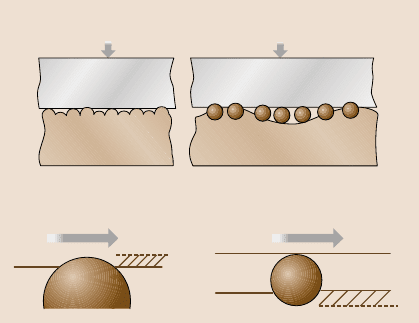
8 Nanotribology, Nanomechanics and Materials Characterization 367
fect. The contribution of wear and contaminant particles is more significant at the
macro/microscale because of the larger number of trapped particles, referred to as
the third-body contribution. It can be argued that, for the nanoscale AFM experi-
ments, the asperity contacts are predominantly elastic (with average real pressure
less than the hardness of the softer material) and adhesion is the main contribution
to the friction, whereas for the microscale experiments the asperity contact are pre-
dominantly plastic and deformation is an important factor. It will be shown later
that hardness has a scale effect; it increases with decreasing scale and is responsible
for less deformation on a smaller scale. The meniscus effect results in an increase
of friction with increasing tip radius (Fig. 8.32). Therefore, the third-body contri-
bution, scale-dependent hardness and other properties, the transition from elastic
contacts in nanoscalecontacts to plastic deformation in microscale contacts, and the
meniscus contribution, play an important role [114–116].
Friction is a complex phenomenon, which involves asperity interactions involv-
ing adhesion and deformation (plowing). Adhesion and plastic deformation imply
energy dissipation, which is responsible for friction, Fig. 8.38 [5,10]. A contact be-
tween two bodies takes place on high asperities, and the real area of contact (A
r
)
is a small fraction of the apparent area of contact. During contact of two asperities,
a lateral force may be required for asperities of a given slope to climb against each
other. This mechanism is known as the ratchet mechanism, and it also contributes
to friction. Wear and contaminant particles present at the interface, referred to as
the third body, also contribute to the friction, Fig. 8.38. In addition, during contact
even at low humidity, a meniscus is formed (Fig. 8.33). Generally any liquid that
wets or has a small contact angle on surfaces will condense from vapor into cracks
and pores on the surfaces as bulk liquid and in the form of annular-shaped capil-
lary condensate in the contact zone. A quantitative theory of scale effects in friction
should consider the effect of scale on physical properties relevant to these various
contributions.
Solid-solid contact
WW
1
2
3
Two body contact Three body contact
Plowing during sliding
1
2
Fig. 8.38. Schematic of two-
bodies and three-bodies dur-
ing dry contact of rough
surfaces

368 Bharat Bhushan
According to the adhesion and deformation model of friction, the coefficient of
dry friction μ is a sum of an adhesion component μ
a
and a deformation (plowing)
component μ
d
. The later, in the presence of particles, is the sum of the asperity-
summit deformation component μ
ds
and the particles deformation component μ
dp
so that the total coefficient of friction is [115]
μ = μ
a
+ μ
ds
+ μ
dp
=
F
a
+ F
ds
+ F
dp
W
=
A
ra
τ
a
+ A
ds
τ
ds
+ A
dp
τ
dp
W
, (8.16)
where W is the normal load, F is the friction force, A
ra
, A
ds
, A
dp
are the real areas of
contact during adhesion, two-bodydeformation and with particles, respectively, and
τ is the shear strength. The subscripts a, ds, and dp correspond to adhesion, summit
deformation, and particle deformation, respectively.
The adhesional component of friction depends on the real area of contact and
adhesion shear strength. The real area of contact is scale dependent due to the
scale dependence of surface roughness (for elastic and plastic contact) and due to
the scale dependence of hardness (for plastic contact) [115]. We limit the analysis
here to multiple-asperity contact. For this case, the scale L is defined as the appar-
ent size of the contact between two bodies. (For completeness, for single-asperity
contact, the scale is defined as the contact diameter.) It is suggested by Bhushan
and Nosonovsky [117] that, for many materials, dislocation-assisted sliding (mi-
croslip) is the main mechanism responsible for the shear strength. They considered
dislocation-assisted sliding based on the assumption that contributing dislocations
are located in a subsurface volume. The thickness of this volume is limited by the
distance which dislocations can climb
s
(material parameter) and by the radius of
contact a. They showed that τ
a
is scale dependent. Based on this, the adhesional
components of the coefficient of friction in the case of elastic contact μ
ae
andinthe
case of plastic contact μ
ap
are given as [117]
μ
ae
=
μ
ae0
+
(
s
/a
0
)
L
L
c
m−n
1+
(
L
s
/L
)
m
, L < L
c
, (8.17)
μ
ap
= μ
ap0
)
*
+
1+
(
d
/a
0
)
1+
(
s
/a
0
)
1+
(
L
s
/L
)
m
1+
(
L
d
/L
)
m
, L < L
c
, (8.18)
where μ
ae0
and μ
ap0
are values of the coefficient of friction at the macroscale
,
L ≥ L
c
-
, m and n are indices that characterize the scale dependence of surface
parameters,
a
0
is the macroscale value of the mean contact radius, L
c
is the long-
wavelength limit for scale dependence of the contact parameters,
s
and
d
are
material-specific characteristic-length parameters, and L
s
and L
d
are length param-
eters related to
s
and
d
. The scale dependence of the adhesional component of the
coefficient of friction is presented in Fig. 8.39, based on (8.17) and (8.18).
Based on the assumption that multiple asperities of two rough surfaces in con-
tact have a conical shape, the two-body deformation component of friction can be
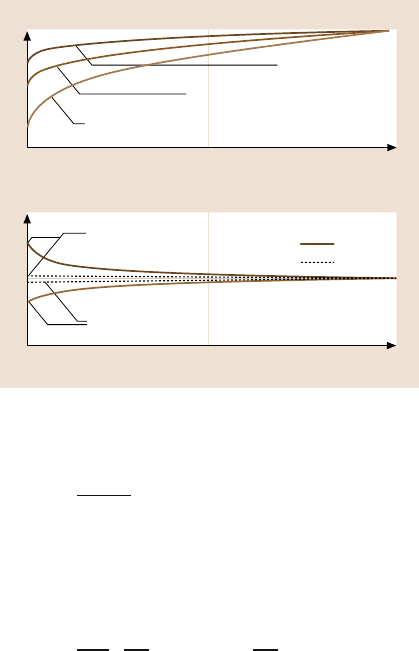
8 Nanotribology, Nanomechanics and Materials Characterization 369
1
0
2
1
0
0 0.5 1
0 0.5 1
Elastic
μ
ae
/μ
ae0
L/L
lc
L
s
/L
lc
= 1000
L
s
/L
lc
= 1
L
s
/L
lc
= 0
Plastic
μ
ap
/μ
ap0
L/L
lc
1
1000
L
d
/L
s
= 0.25
L
d
/L
s
= 5
L
d
/L
lc
Fig. 8.39. Normalized results
for the adhesional compo-
nent of coefficient of friction,
as a function of L/L
c
for
multiple-asperity elastic con-
tact. Data are presented for
m= 0.5, n= 0.2. Formultiple-
asperity plastic contact, data
are presented for two values
of L
d
/L
c
[115]
determined as [5,10]
μ
ds
=
2tanθ
r
π
, (8.19)
where θ
r
is the roughness angle (or attack angle) of a conical asperity. Mechanical
properties affect the real area of contact and shear strength and these cancel out in
(8.16) [115]. Based on statistical analysis of a random Gaussian surface [115]
μ
ds
=
2σ
0
πβ
∗
0
L
L
c
n−m
= μ
ds0
L
L
c
n−m
, L < L
c
, (8.20)
where μ
ds0
is the value of the coefficient of the summit-deformation component
of the coefficient of friction at the macroscale
,
L ≥ L
c
-
,andσ
0
and β
∗
0
are the
macroscale values of the standard deviation of surface heights and correlation
length, respectively, for a Gaussian surface. The scale dependence for the two-body
deformation component of the coefficient of friction is presented in Fig. 8.40a for
m = 0.5, n = 0.2, based on (8.20). The coefficient of friction increases with decreas-
ing scale, according to (8.20). This effect is a consequence of increasing average
slope or roughness angle.
For three-body deformation, it is assumed that wear and contaminant particles
at the borders of the contact region are likely to leave the contact region, while
the particles in the center are likely to stay (Fig. 8.41). The plowing three-body
deformation is plastic and, assuming that particles are harder than the bodies, the
shear strength τ
dp
is equal to the shear yield strength of the softer body τ
Y
,the
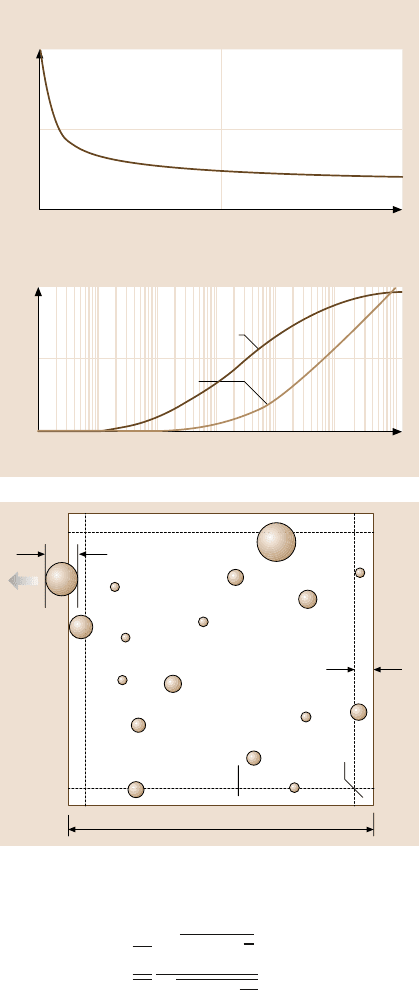
370 Bharat Bhushan
5
2.5
0
0 0.5 1
1
0.5
0
10
0
10
2
10
4
10
6
Asperities plowing contribution
L/L
lc
μ
ds
/μ
ds0
m = 0.5
n = 0.2
Three body plowing contribution
Fraction of trapped particles
Coefficient of friction
n
tr
, μ
dp
/μ
dp0
Log normal distribution
L/α (nm)
ln(d
ln
) = 2,
σ
ln
= 1, l
d
/σ
ln
= 1
Fig. 8.40. Top Normalized
results for the two-body
deformation component of
the coefficient of friction,
and bottom the number of
trapped particles divided by
the total number of particles
and three-body deformation
component of the coefficient
of friction, normalized by
the macroscale value for
log-normal distribution of
debris size, where α is the
probability of a particle in
the border zone to leave
the contact region. Various
constants given in the figure
correspond to the log-normal
distribution [115]
L
Contact region
d
d/2
Border region Corner
Fig. 8.41. Schematics of
debris at the contact zone and
at its border region. A particle
of diameter d in the border
region of d/2islikelytoleave
the contact zone [115]
three-body deformation component of the coefficient of friction is given by [116]
μ
dp
= μ
dp0
n
tr
d
2
d
2
0
!
1+ 2
d
/d
!
1+ 2
d
/d
0
, (8.21)
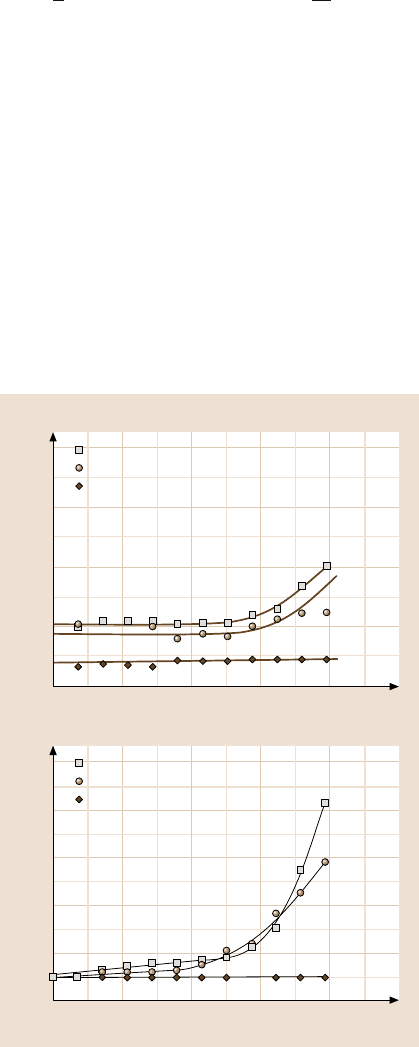
8 Nanotribology, Nanomechanics and Materials Characterization 371
where d is the mean particle diameter, d
0
is the macroscale value of the mean par-
ticle diameter, n
tr
is the number of trapped particles divided by the total number
of particles, and μ
dp0
is the macroscale
(
L →∞,n
tr
→ 1
)
value of the third-body
deformation component of the coefficient of friction. The scale dependence of μ
dp
is shown in Fig. 8.40 based on (8.21). Based on the scale-effect predictions pre-
sented in Figs. 8.39 and 8.40, trends in the experimental results in Table 8.3 can be
explained.
The scale dependence of meniscus effects in friction, wear and interface temper-
ature can be analyzed in a similar way [116].
To demonstrate the load dependence of friction at the nano/microscale, the co-
efficient of friction as a function of normal load is presented in Fig. 8.42. The coef-
ficient of friction was measured by Bhushan and Kulkarni [28,29] for a Si
3
N
4
tip
versus Si, SiO
2
, and natural diamond using an AFM. They reported that, for low
loads, the coefficient of friction is independent of load and increases with increasing
load after a certain load. It is noted that the critical value of loads for Si and SiO
2
Si(111)
SiO
2
Natural diamond
Si(111)
SiO
2
Natural diamond
Coefficient of friction
Normal load (PN)
050
0.2
0.15
0.1
0.05
0
10 20 30 40
Wear depth (nm)
Normal load (PN)
050
45
35
25
15
5
–5
10 20 30 40
a)
b)
Fig. 8.42. Coefficient of
friction as a function of
normal load and for Si(111),
SiO
2
coating and natural
diamond. Inflections in the
curves for silicon and SiO
2
correspond to the contact
stresses equal to the hardness
of these materials [28]
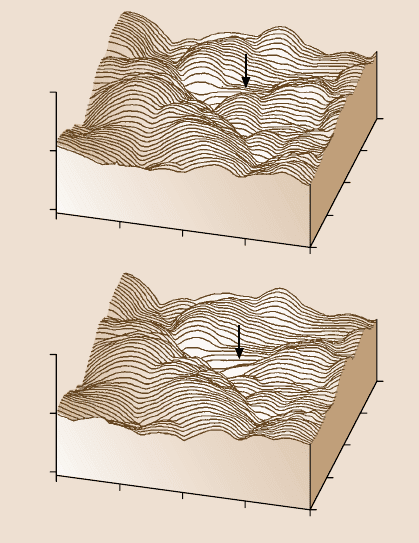
372 Bharat Bhushan
corresponds to stresses equal to their hardness values, which suggests that the tran-
sition to plasticity plays a role in this effect. The friction values at higher loads for
Si and SiO
2
approach that of macroscale values.
8.4 Wear, Scratching, Local Deformation,
and Fabrication/Machining
8.4.1 Nanoscale Wear
Bhushan and Ruan [23] conducted nanoscale wear tests on polymeric magnetic
tapes using conventional silicon nitride tips, at two different loads of 10 and 100nN,
Fig. 8.43. For a low, normal load of 10nN, measurements were made twice. There
was no discernible difference between consecutive measurements for this load.
However, as the load was increased from 10nN to 100 nN, topographical changes
were observed during subsequent scanning at a normal load of 10nN; material was
pushed in the sliding direction of the AFM tip relative to the sample. The material
movement is believed to occur as a result of plastic deformation of the tape sur-
face. Thus, deformation and movement of the soft materials on a nanoscale can be
observed.
400
0
0
100
200
300
400 nm
25.0
50.0
nm
300
200
100
0
400
0
0
100
200
300
400 nm
25.0
50.0
nm
300
200
100
0
10 nN
100 nN
Fig. 8.43. Surface roughness
maps ofa polymeric magnetic
tape at the applied normal
load of 10 nN and 100 nN.
Location of the change in
surface topography as a result
of nanowear is indicated by
the arrows [23]
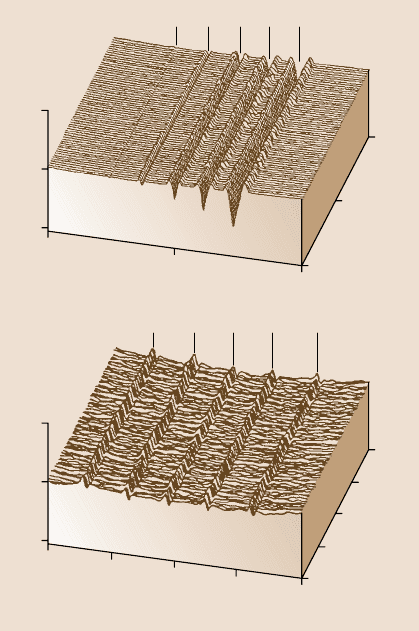
8 Nanotribology, Nanomechanics and Materials Characterization 373
8.4.2 Microscale Scratching
The AFM can beused to investigatehowsurface materialscan be movedor removed
on the micro- to nanoscales, for example, in scratching and wear [4, 11] (where
these things are undesirable), and nanofabrication/nanomachining (where they are
desirable). Figure 8.44a shows microscratchesmade on Si(111) at various loads and
a scanning velocity of 2 µm/s after 10cycles [27]. As expected, the scratch depth
increases linearly with load. Such microscratching measurements can be used to
study failure mechanisms on the microscale and to evaluate the mechanical integrity
(scratch resistance) of ultra-thin films at low loads.
To study the effect of scanning velocity, unidirectionalscratches, 5 µm in length,
were generated at scanning velocities ranging from 1 to 100µm/s at various normal
loads ranging from 40 to 140µN. There is no effect of scanning velocity obtained at
a givennormal load.Forrepresentativescratch profilesat 80 µN,see Fig.8.44b.This
may be because of a small effect of frictional heating with the change in scanning
velocity used here. Furthermore, for a small change in interface temperature, there
is a large underlying volume to dissipate the heat generated during scratching.
5.00
0
0
2.50
5.00 μm
200
400
nm
2.50
0
4.00
0
0
2.00
4.00 μm
10.0
20.0
nm
2.00
0
1.00
3.00
3.00
1.00
10 20 40 60 80 μN
1 10 25 50 100 μm/s
a)
b)
Fig. 8.44. Surface plots of
(a) Si(111) scratched for
ten cycles at various loads
and a scanning velocity of
2 µm/s. Note that x and y axes
are in µmandthez axis is in
nm, and (b) Si(100) scratched
in one unidirectional scan
cycle at a normal force of
80 µN and different scanning
velocities
